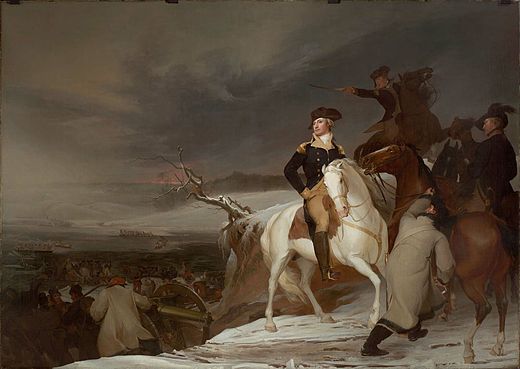What was George Washington’s plan when he crossed the Delaware River tonight?
 December 25–26, 1776 — George Washington’s famous crossing of the Delaware River occurred tonight during the American Revolutionary War. It was the first move in a surprise attack organized by Washington against the Hessian forces in Trenton, New Jersey.
December 25–26, 1776 — George Washington’s famous crossing of the Delaware River occurred tonight during the American Revolutionary War. It was the first move in a surprise attack organized by Washington against the Hessian forces in Trenton, New Jersey.
Planned in partial secrecy, Washington led a column of Continental Army troops across the icy Delaware River in a logistically challenging and dangerous operation. Other planned crossings in support of the operation were either called off or ineffective, but this did not prevent Washington from surprising and defeating the troops of Johann Rall quartered in Trenton. The army crossed the river back to Pennsylvania, this time laden with prisoners and military stores taken as a result of the battle.
Washington’s army then crossed the river a third time at the end of the year, under conditions made more difficult by the uncertain thickness of the ice on the river.
On January 2, 1777 — Washington and his troops defeated British reinforcements under Lord Cornwallis at Trenton, and defeated his rear guard at Princeton on January 3, before retreating to winter quarters in Morristown, New Jersey.
The unincorporated communities of Washington Crossing, Pennsylvania and Washington Crossing, New Jersey are named in honor of this event.
Sources
Words of Wisdom
On the morning of December 25, George Washington ordered his army to prepare three days' food, and issued orders that every soldier be outfitted with fresh flints for their muskets. He was also somewhat worried by intelligence reports that the British were planning their own crossing once the Delaware was frozen over.
At 4 pm Washington's army turned out for its evening parade, where the troops were issued ammunition, and even the officers and musicians were ordered to carry muskets. They were told that they were departing on a secret mission. Marching eight abreast in close formations, and ordered to be as quiet as possible, they left the camp for McKonkey's Ferry.
Washington's plan required the crossing to begin as soon as it was dark enough to conceal their movements on the river, but most of the troops did not reach the crossing point until about 6 pm, about ninety minutes after sunset.
The weather got progressively worse, turning from drizzle to rain to sleet and snow. It blew a hurricane, recalled one soldier.





